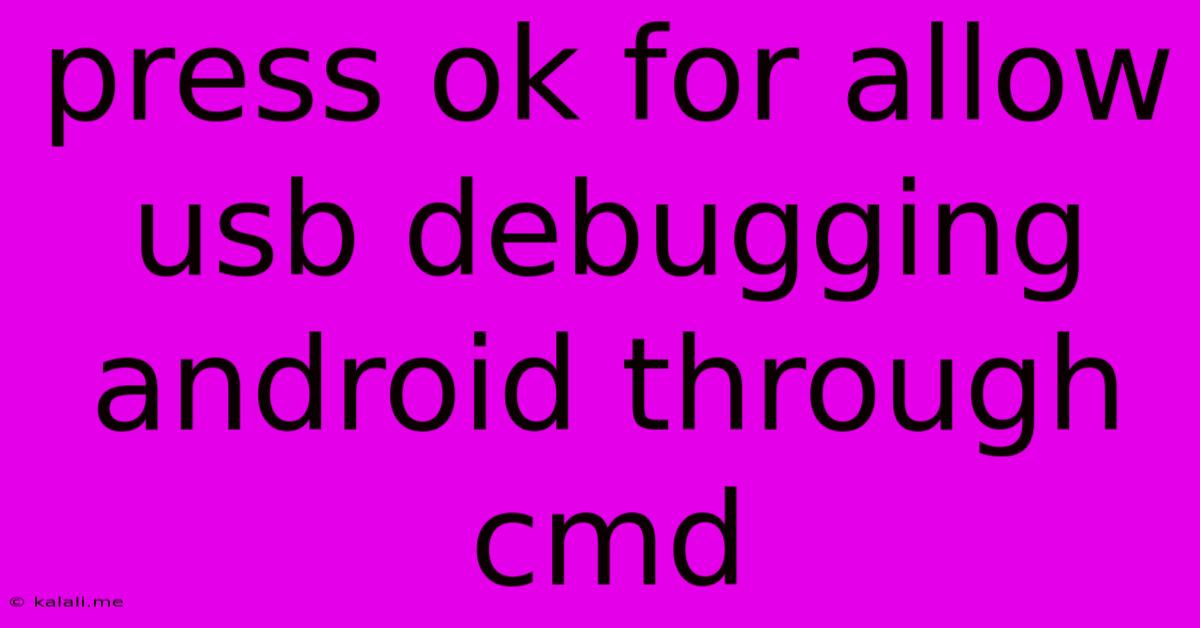Press Ok For Allow Usb Debugging Android Through Cmd
Kalali
May 31, 2025 · 3 min read

Table of Contents
Enabling USB Debugging on Android via CMD: A Comprehensive Guide
Enabling USB debugging on your Android device is often a necessary step for tasks like software development, data transfer, or using certain Android debugging tools. While the typical method involves navigating through your phone's settings, you can also achieve this through the command line interface (CMD) using ADB (Android Debug Bridge). This guide will walk you through the process, addressing potential issues and offering troubleshooting tips. This method is particularly useful for devices with touchscreen issues or for automation purposes.
What is USB Debugging and Why Use CMD?
USB debugging is a feature that allows communication between your Android device and a computer. It opens a bridge for advanced functionalities, including installing apps not from the Google Play Store, transferring files, and using command-line tools for development and troubleshooting. Using CMD provides a streamlined, text-based approach that is convenient for experienced users and scripting.
Prerequisites: Setting up ADB
Before you begin, ensure you have the necessary components installed:
-
Install Android Studio (Recommended): Android Studio is the official IDE from Google, and it includes the ADB tool within its package. This is the easiest way to ensure you have the correct version of ADB.
-
Install the appropriate USB drivers: You need the correct USB drivers for your specific Android device model. These drivers are essential for your computer to recognize your device. These drivers can often be found on the manufacturer's website.
-
Enable Developer Options on your Android Device: This setting is usually hidden. To enable it, go to your phone's Settings > About Phone and tap on the Build Number repeatedly until you see a message confirming that Developer Options have been enabled.
-
Enable USB Debugging in Developer Options: Once Developer Options are enabled, navigate back to Settings > System > Developer Options and toggle on USB Debugging. You might see a prompt on your phone asking for confirmation; accept it.
The CMD Commands: Enabling USB Debugging through ADB
Once you've completed the prerequisites, connect your Android device to your computer using a USB cable. Now, open your command prompt (CMD) or terminal and navigate to the platform-tools folder within your Android Studio installation directory. The exact path will vary depending on your Android Studio installation, but it will usually resemble this: C:\Users\[YourUserName]\AppData\Local\Android\Sdk\platform-tools.
Here's the command to execute:
adb devices
This command lists all connected Android devices recognized by ADB. You should see your device listed with a serial number. If it's not listed, double-check your USB connection and drivers.
If your device is listed, proceed with these commands:
adb shell settings put global adb_enabled 1
This command enables ADB debugging through the system settings.
Troubleshooting and Common Issues:
- Device not recognized: This is the most common issue. Ensure you've installed the correct USB drivers and that your device is correctly connected. Check your device's USB configuration; it might be set to charge only.
- Authorization required: Your Android device might prompt you to authorize USB debugging on the screen. Make sure to grant permission.
- Incorrect path: Double-check the path to your
platform-toolsdirectory. A small typo can prevent the commands from working. - Driver issues: Reinstall or update your USB drivers. Sometimes, older or corrupted drivers can cause problems.
Conclusion:
Enabling USB debugging through CMD provides a powerful and efficient way to interact with your Android device. While this method requires a bit more technical understanding, it offers a valuable alternative to the standard graphical interface, particularly useful in situations requiring automation or when dealing with devices with limited or damaged screens. Remember to carefully follow the steps and troubleshoot potential issues to ensure a smooth process.
Latest Posts
Latest Posts
-
Fallout Shelter What Does Luck Do
Jun 02, 2025
-
How To Keep Pipes From Freezing Without Power
Jun 02, 2025
-
How To Replace Pull Chain On Ceiling Fan
Jun 02, 2025
-
How To Repair Crumbling Cement Walls
Jun 02, 2025
-
Ho Can Companies Kep Their Source Code Private
Jun 02, 2025
Related Post
Thank you for visiting our website which covers about Press Ok For Allow Usb Debugging Android Through Cmd . We hope the information provided has been useful to you. Feel free to contact us if you have any questions or need further assistance. See you next time and don't miss to bookmark.